 |
Dr. Simon Mays with infant remains from a Hambleden villa.
Image courtesy of the UK Daily Mail.
|
"A previous excavation of Hambleden in 1921 determined that the site has 97 infant burials, the largest number of such burials for any Roman location in Britain. The excavator at the time suspected infanticide "with surreptitious disposal of the bodies." - Child Exposure in the Roman Empire by William V. Harris, The Journal of Roman Studies Vol. 84, (1994), pp. 1-22
I was surprised when I read the original manuscript of the study that it included no estimates of fertile population of the large villa complex over four centuries (the villa is thought to have been occupied and productive from the first to the fourth century CE). It also included no projections of normal infant mortality rates, no anthropological context for the people living in or near the villa, no discussion of economic history of the area, no discussion of societal motive, no analysis of parental origins as indicated by DNA analysis for geographic markers, and no discussion of differences in funerary practices between newborn and more mature offspring. (In fact, W.V. Harris, in his paper "Child Exposure in the Roman Empire" dismisses the infant burials at Hambleden as evidence of widespread infanticide because of the Roman practice of burying infants but cremating older family members thereby creating the concentrated burial anomaly.)
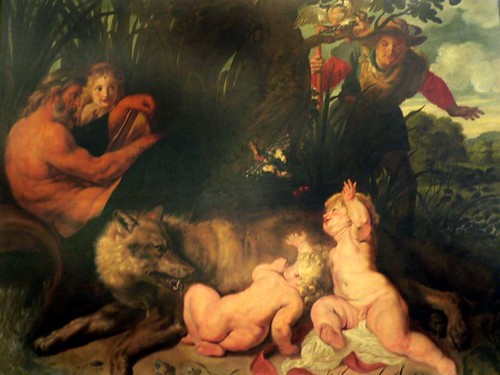 |
Romulus and Remus Suckled by Lupa by Peter Paul Rubens.
Photographed at The Capitoline Museum in Rome
by Mary Harrsch.
|
So, was infanticide and child exposure really common in the Roman Empire?
As students of antiquity, most of us are aware that Greek (and to some extent Roman) mythology is rife with tales of famous heroes who, because of exposure as an infant outcast, were adopted by compassionate passersby and achieved incredible feats in their later years.
Danae and Perseus - based on a fragment from Simonides by Peter John Allan
 |
| Perseus and Danae by John William Waterhouse, 1892. |
When now, above the fragile bark,
The howling tempest gathered dark,
And wide the foaming billows spread,
Danäe, wild with rising fears,
Her eyes bedew'd with bitter tears,
Round Perseus threw her arms, and said:-
'Thou durst not guess, O babe divine!
The griefs that rend this heart of mine;
Thou sleepest on thy mother's breast,
Nor knowest how weak a bark is ours,
Nor dread'st the angry ocean's powers-
The winds but lullaby thy rest.
'Wrapt in thy little cloak, my child,
Thou heed'st not the waters wild,
As o'er thy long dark hair they sweep;
My love, my life! if thou couldst see
Thy hapless mother's misery,
Those slumb'ring eyes would learn to weep.
'Yet sleep, my boy-I charge thee sleep,
And slumber thou, resistless deep,
And sleep ye, too, my many woes;
Oh! grant, great Jove, a mother's prayer,
My Perseus in thy mercy spare
(Rash wish!) to punish Danäe foes.'
Similar fates supposedly befell not only Perseus but Paris of Troy, Oedipus the King, Sargon the Great and, of course, Romulus and Remus. Although infanticide through exposure was a popular dramatic device in the ancient world, how common was the act in daily life?
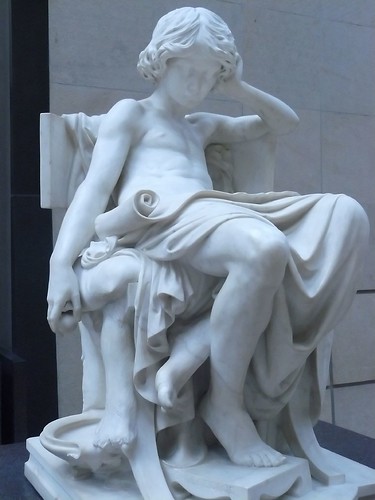 |
Young Aristotle by Charles Degeorge 1875 CE
Photographed at the Musee d'Orsay in Paris,
France by Mary Harrsch. |
Plato (428/427 BCR – 348/347 BCE) , in his Republic, suggests that children of "inferior guardians" should be exposed. His equally famous student Aristotle went on to imply that some Greek cities forbade exposure if it was done on demographic or economic grounds. Harris reasons that this observation must lead us to believe that in other Greek cities, child exposure carried no such sanction.
Isocrates(436–338 BCE) includes the exposure of infants in his catalog of horrendous crimes practiced in some cities (other than Athens) in his work Panathenaicus.
The comic dramatist Poseidippus of Cassandreia ( (316 BC – ca. 250 BCE) wrote:
Everyone, even if he is poor, rears a son,
But exposes a daughter, even if he is rich
"...the perceived reality is ... that in the author's world parents often did expose infant children ...." - Child Exposure in the Roman Empire by William V. Harris, The Journal of Roman Studies Vol. 84, (1994), pp. 1-22
"Plato and Aristotle, as well as the Stoics, Epicurus, and presumably Plotinus, accept the morality of the exposure of infants...on eugenic or sometimes on purely economic grounds...We see here further clear evidence of the ancient view that somehow value is acquired, either by the development of intelligence or by the acceptance into society. There is no reason to think that the philosophers made substantial advances on the assumptions of the general public in this regard." - Human Value: A Study in Ancient Philosophical Ethics, John M. Rist, Leiden: E. J. Brill, 1982, pg. 9.
So far, though, all of these sources are Greek and refer to Greek or Hellenized cultures of the Near East and Egypt. How did attitudes differ in Roman society, especially in the heartland of Italy?
Theopompus, a Greek historian from Chios (born c. 380 BCE) pointed out that the Etruscans were remarkable because they reared all of their children. The Etruscans heavily influenced Roman culture until around 400 BCE although some customs, especially those surrounding augury and funerary rites continued well beyond that point.
 |
| Medea killing her children by Eugene Delacroix, 1838. |
The killing and even the abandonment of children after they had been accepted into a family seems to have been a horrific event in the Graeco-Roman world, and the readiness of many ancient parents to expose their not-yet-accepted infant children contrasts with their protectiveness towards children once they had passed that stage. - Child rearing in ancient Italy: The Family in Italy from Antiquity to the Present, P. Garnsey and D. I. Kertzer and R. P. Saller (eds), , (I99I), 48-65.
In our literary sources Cicero refers to the pater familias' picking-up (suscipere, tollere) of the new-born child as a deliberate act of recognition which may or may not take place. What happened to a newly born child that for some reason was shunned by the head of the household?
Harris says there is little evidence to support a widespread practice of infant exposure in the Roman world up to the late Republican Period.
He does mention a quotation from Polybius (200–118 BCE), however, in which the historian criticizes the exposure of children and blames such practices for the depopulation of Greece. Polybius is talking about Greece but may have intended it as a warning about the consequences of such activities to the Romans who he served for 17 years as a distinguished hostage.
I find the timing of this admonition particularly interesting since it followed the wholesale integration of Greek culture into the Roman world that occurred after the sack of Syracuse by Marcus Claudius Marcellus in the Second Punic War that is viewed by many scholars as the point of a major cultural shift in Roman history.
 |
Bust of Cicero 1st century BCE
photographed at The Capitoline
Museum by Mary Harrsch © 2005
|
However, the Senate supposedly overrode such legal directives when auguries foretold of impending disaster. In his biography of Augustus, Suetonius says there was a story put about by a freedman of Augustus recalling that an evil portent in 63 BCE led to a senatorial decree forbidding the raising of any boy born that year.
 |
The Roman emperor Augustus as
the Pontifex Maximus photographed
at the Palazzo Massimo in Rome by
Mary Harrsch
|
These laws were accompanied by sumptuary laws that restricted luxury items and extravagance. Many scholars assume this was an effort to force people to adopt Augustus' own religious views but what if they were meant to remove one of the recognized motivations for infanticide - the wish to acquire and display wealth as opposed to spending it on offspring?
Roman Egypt was evidently afflicted with a high incidence of infanticide as Harris points to an admonition from Hellenized Jewish philosopher Philo of Alexandria who extols the cruelty of child killers in his treatise "On Special Laws" although Harris includes the fact that Philo was addressing the Jews and other inhabitants of a long-Hellenized culture.
Suetonius also wrote of a famous grammatici born free at Spoletium near the very end of the Republic and exposed 'because of discordia between his parents', then rescued for profit in the slave market. This passage also raises the issue of foundling collection centers that cropped up around the Empire. These institutions sought to harvest the abandoned for the lucrative slave market.
Some scholars point out that at times when the slave market was flush from new conquests, this activity would not have been profitable, but by the time of Augustus, most large scale conquests had ended and the borders of the Empire were approaching their maximum extent, with the exception of Britain and fluctuations along the eastern borders.
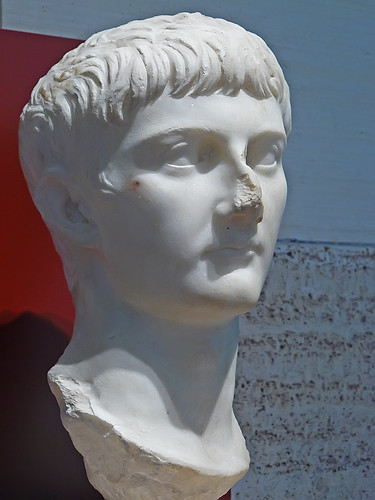 |
Portrait of Germanicus, 1st
century CE photographed at
the Palazzo Massimo by
Mary Harrsch.
|
"Such was the public's grief at the death of Germanicus [father of Caligula] in the year A.D. I9 that parents exposed their infant children."
However, this example emphasizes the extreme nature of the act, not an act widely accepted as common practice.
Musonius Rufus, a Stoic philosopher in Rome during the reign of Nero, writes passionately about an apparent contemporary practice of infant exposure by the prosperous as well as the poor.
"But what seems to me very terrible is that some who do not even have poverty as an excuse but are prosperous and even wealthy none the less have the effrontery not to rear later-born offspring in order that those born earlier may inherit greater wealth .... So that their children may have a greater share of their father's goods, they destroy their children's brothers."- Gaius Musonius Rufus, "Whether all children who are born should be reared?"
Seneca, Nero's tutor, wrote, "Mad dogs we knock on the head; the fierce and savage ox we slay; sickly sheep we put to the knife to keep them from infecting the flock; unnatural progeny we destroy; we drown even children who at birth are weakly and abnormal. Yet it is not anger, but reason that separates the harmful from the sound."
 |
Portrait of Epicurus photographed
at Palazzo Massimo by
Mary Harrsch.
|
Epictetus ( 55 – 135 CE) criticized Epicurus for approving the exposure of children, saying that even a sheep or a wolf does not abandon its own offspring.
Hierocles (in Stobaeus IV.24. 14), echoes the same sentiment claiming "most people" seem to decline to raise (some of) their children for a not very lofty reason, love of wealth and the belief that poverty (penia) is a terrible evil.
I can't help but wonder about these philosophical exhortations, though, since researchers claim birth control methods used by the Romans, particularly the more affluent members of society were actually quite effective which would seemingly negate the need for infanticide.
J. M. Riddle put forward powerful arguments in favour of the effectiveness of the oral contraceptives and abortifacients known in Roman antiquity in his 1992 study, Contraception and Abortion from the Ancient World to the Renaissance.
Harris points out, though, that unlike contraception or abortion, it [the reliance on exposure of unwanted offspring] permitted them to choose the sex of their children. In fact, some scholars point to a perceived gender inequity that existed in the Roman Empire as a clear indication that female infants were killed or discarded but Harris observes that it could have also been explained by gender-differentiated child care.
 |
Ancient relief depicting childbirth with female in attendance -
not a male physician.
|
I was surprised that Harris did not mention the more obvious hazards of childbirth in the ancient world, especially among females in their early teens at the time of their first conception. Added to the heavy losses from childbirth are the losses from attempted abortions for unwanted offspring, both hazards unique to the female population. Another important factor that could skew an analysis of numbers of males is the nutrition and superior medical care that young men received in the military. Military scholars have concluded that Roman males in the legions actually enjoyed a much longer life span, despite the violent nature of their occupation, than civilian males because of the higher quality diet they received and the advanced skills of the military physicians. So, I am not convinced by less than dramatic perceived differences in gender equity.
Harris attempts to tease out a reasonable percentage of child exposures or infanticides in the Roman Empire by calculating Gross Reproduction Rates that take into account the young age at marriage and average lifespan of Roman women. But, although he does take into account a reduced reproduction from effective contraceptives, he surprisingly does not mention high maternal mortality rates that have been shown to occur when first pregnancies occur in very young women with absent or marginal medical care. Instead Harris suggests that lower female ages at marriage and/or better medical care may have actually increased fertility in the Roman Empire thereby increasing infanticide rates when compared to those of medieval and Renaissance Europe and Ming China studied by other scholars.
However, although the elite classes in Roman Society enjoyed surprisingly effective medical care, I doubt that the vast majority of women in the "Roman mob" would have had access to medical care much beyond mid-wives, which, when combined with the complications inherent in the delivery process with very young mothers surely could not have increased the rate of live births and in all probability would have had a depressive effect on fertility rates during the Roman period.
In a study prepared in 1980, Donald Engles takes these reservations a step further when he totally dismisses the possibility that female infanticide was practiced on any significant scale.
"Clearly, high rates of female infanticide were impossible for any ancient population. Even low rates of female infanticide would increase the death rate and lower the birth rate, and in a stable or nearly stable population, this would cause the population to decline at a geometric rate. For these reasons, a rate of 10 percent of female births killed per year would be highly improbable, and the rate almost certainly never exceeded more than a few percent of female births in any era. - The Problem of Female Infanticide in the Greco-Roman World by Donald Engels, Classical Philology Vol. 75, No. 2 (Apr., 1980), pp. 112-120.
And yet, Harris claims that an array of texts makes it obvious that exposure of infants was widely practiced in the high Roman Empire, though.
But Harris points out that in Book VI of Plutarch's Moralia entitled De amore prolis (On Affection for Offspring), Plutarch (46-120 CE) says the poor do not bring up their children for they fear that without an appropriate upbringing they will grow up badly; Harris says this must indicate a sustantial amount of exposure of healthy children among the author's contemporaries.
Harris also quotes a letter from Pliny the Younger to the Roman emperor Trajan (Ep. x.65-6):
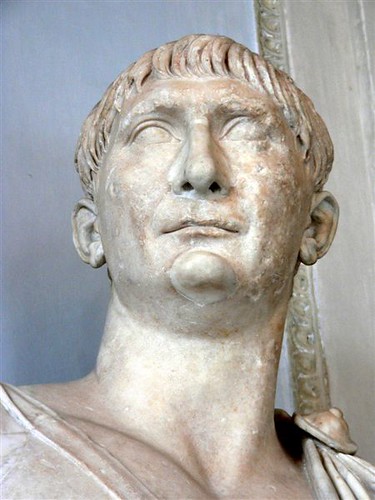 |
Portrait bust of the Roman emperor Trajan
98 - 117 CE. Photographed at The Capitoline
Museum by Mary Harrsch.
|
"He [Pliny] consults the emperor [Trajan] about the threptoi, in other words 'those who having been born free, were exposed, then picked up by someone and brought up in slavery', a great issue, he says, concerning his entire province. Emperors since Augustus had often given rulings on the subject affecting other provinces, but never with respect to Bithynia; Trajan rules that claims to freedom are not to be made contingent on the payment of alimenta."
Harris thus concludes that child-exposure was or had been at least fairly widely practiced in the provinces of Achaea and Bithynia-Pontus as late as the early 2nd century CE.
In Rome, itself, however, the elite, including Trajan had rejected the practice.
"Tacitus' writings in 98 CE coincide closely with the creation of the imperial alimenta in Italy. This programme implied opposition to all forms of family limitation. By the time of Nerva criticism of child-exposure had spread from philosophers and moralists to leading Romans of more pragmatic mentality. The imperial alimenta, which aimed at population increase in Italy by means of subsidies specifically directed towards children, were preceded and, on a much larger scale, followed by private philanthropy with similar aims." - Child Exposure in the Roman Empire by William V. Harris, The Journal of Roman Studies Vol. 84, (1994), pp. 1-22
By the late second century, there appeared to be considerable opposition to the practice.
"The most intriguing piece of possibly Severan evidence, however, is the statement in Paul's Sententiae (Dig. xxv.3.4 - a summary of Roman laws), which equates the exposure of an infant with killing .... it would mean that exposers who did not possess patria potestas now became criminals ..." - Child Exposure in the Roman Empire by William V. Harris, The Journal of Roman Studies Vol. 84, (1994), pp. 1-22
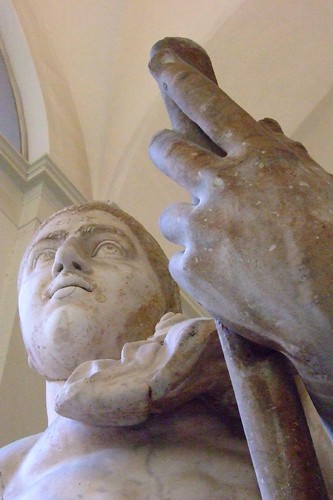 |
Reproduction of 3rd century CE heroic
statue of Roman Emperor Alexander
Severus at the archaeological museum
in Naples. Photo by Mary Harrsch.
|
Then in 228 CE, the Emperor Alexander takes the next step and eliminates the right of even a pater familias to impose a death sentence on a child.
"...if the father wished to impose more severe punishment on a child than simple flogging, he must apply to the highest judicial authority, the President of the Province, for his sanction." - A systematic and historical exposition of Roman law in the order of a code by William A. Hunter, 1903.
These changes to Roman law demonstrate an important differetiation that has occurred in the social acceptance of infanticide by the late second and early third centuries C.E.. Athough exposure, with its indefinite outcome, is still problematic enough for Roman administration to continue to issue legal clarifications about the practice, outright infanticide has been criminalized. The infant has now acquired recognized social value as a human being.
I find this development particularly relevant to our examination of the claims made in the study of the Hambleden infant remains. The infant burials at Hambleden would probably not be the result of exposure but from natural death or infanticide since the remains were buried in close proximity to the living quarters. Based on the legal references above, infanticide was viewed, from the end of the second century or early third century onward, as not just frowned upon but tacitly illegal. So, unless a number of people at Hambleden were willing to repeatedly commit illegal acts, wholesale infanticide would seem highly unlikely to have occurred in the last two centuries of the villa's occupation unless inhabitants of provincial Britain ignored Roman tenets regarding domestic activities. I suppose this might largely depend on the culture of the inhabitants of the villa, especially if most of the inhabitants were indigenous peoples working the villa as peasants and not slaves of the household.
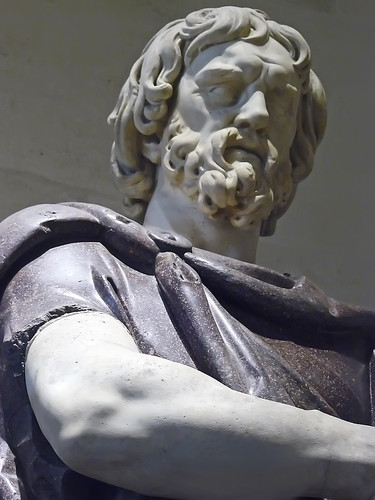 |
Sculpture of Barbarian captive thought to be
Dacian recovered from Trajan's Forum.
Photographed at The Louvre by Mary Harrsch.
|
"Little is known of the system of land tenure in the province of Britain or of the amount of slavery which developed there. Tacitus ascribes to the British chieftain, Calgacus, a knowledge of slavery. This may be either a proof of the existence of slavery in pre-Roman Britain or a reflection in the free areas of Britain of conditions developing in that portion of the island which had already been conquered by the Romans. It has been generally assumed that the peasants of Britain fell into a position somewhat similar to that of the Roman coloni. Inasmuch as the Romanization of Britain occurred at a atime when the decline in slave employment had already begun in Italy it is a reasonable supposition that industrial slavery, and probably agricultural employment of slaves, never developed to the point where they became important factors in the economic life of the island." - The slave systems of Greek and Roman antiquity by William Linn Westermann.
Unfortunately, an analysis of gestational age of the Hambleden infant remains without skeletal dating studies gives us no way to definitely eliminate the last half of the villa's period of occupation. I found no references to DNA analysis either that would help us determine if the infants were from indigenous parents or parents of Mediterranean origin, something that would need to be addressed to label just the "Romans" as perpetrators of infanticide.
But lets examine historical events in the first and second centuries that may have motivated parents to commit infanticide and try to determine the cultural context.
 |
Detail of a 17th century tapestry by Pietro da Cartona depicting a Roman
sea battle. Photographed at the Philadelphia Museum of Art by
Mary Harrsch.
|
The invasion of Britain in the first century could have been considered catastrophic enough to trigger the sacrifice of newborns by indigenous people attempting to persuade the gods to lend them assistance in their resistance to the invading Romans. Researchers at Hambleden were appalled to discover at least one infant skeleton with cut marks indicating it had been possibly ritually dismembered.
"Human bones are a very small part of total bone assemblages from Iron Age sacred and occupation sites, but examples [of apparent sacrifice] do turn up with macabre frequency. Pieces of human skull at Hayling, the limbs and torso from a pit at Danebury, and the pathetic remains of a dismembered child from Wandlebury point to the sacrifice of human beings, perhaps of enemies. Possibly cannibalism was involved as well. It is not easy to separate the atrocities attributed for instance to the followers of Boudica from religious activities. The Romans had no doubt that the Druids were involved, and we are in no position to dismiss this allegation. Human sacrifice was something that the Romans found repellent..." - Religion in Roman Britain by Martin Henig.
But Henig goes on to point out that there is little evidence to indicate human sacrifice continued under Roman rule, especially in the rural areas. He also notes that even in cases where ritual infanticide appears most probable such as at Springhead where infant skeletons were found under foundations at the corners of buildings, there are alternative explanations such as the presence of a shrine associated with childbirth like the Roman Juno Lucina.
If the conquest had resulted in large scale enslavement, another motivator identified by Harris, infants may have been killed by their parents so the children would not have to endure the humiliation and hardship of a slave's life. This motivator most probably would have spurred newly enslaved populations to such extremes but probably not slaves who had been born into slavery as they would have been accustomed to their social position unless they had the misfortune to belong to an extremely cruel household. But if Westermann is correct, enslavement on a grand scale did not occur in Roman Britain.
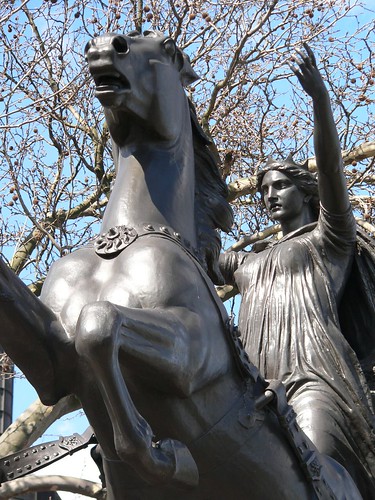 |
A monument of Boudicca on the banks of the
Thames River in London, England.
Photo by Mary Harrsch
|
Could the Boudiccan Revolt in 60 or 61 CE have been considered enough of a bad omen to trigger infanticide? Possibly, but there's no literary evidence to support this suggestion like there was for the death of Germanicus in 19 CE. However, the destruction in surrounding territories could have caused a regional famine.
Famine or severe economic hardship is thought to have been one of the primary forces triggering infanticide in the ancient world. This motivator could have effected both indigenous and Roman inhabitants of the villa. But, I found no references to climate data or evidence of localized catastrophe such as a destruction layer at the Hambledon site so we have no physical evidence of such an event. The productive capacity of the villa would need to be evaluated to see if it was capable of sustaining itself without imported goods as trade was most likely disrupted during the rebellion.
The use of infantcide to control family size and maximize wealth and inheritance, declaimed so loudly by the philosophers, could have occurred within families of both Roman and non-Roman inhabitants, especially if those employed in the agricultural operation were, in fact, non-slaves as Henig proposes. But Riddle claims contraceptives and abortifacients known to the Romans were very effective so the only remaining reason to risk the dangers of childbirth would be to produce a male heir or escape the necessity to use wealth for a dowry, both pointing to female infanticide. I doubt if there is any way to trace the genealogy of the villa's owners over the centuries to determine inheritance issues and without gender analysis to identify gender inequity in the Hambleden remains, there's no way to know if female remains exceeded male remains to an extent to indicate preferential female infanticide. We also don't know if the Romans shared their family planning knowledge with non-Romans in the villa either so we can't discount the non-Romans using infanticide in place of general birth control.
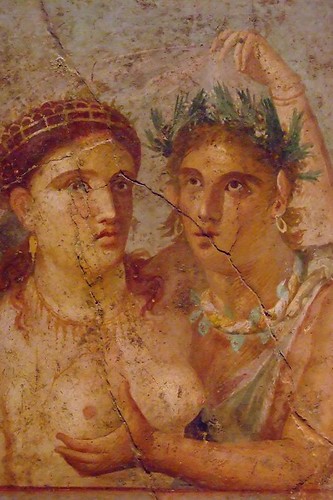 |
Erotic fresco recovered from Pompeii
that was once displayed in the "Secret
Room" in the archaeological museum in
Naples, Italy. Photo by Mary Harrsch.
|
Researchers have proposed that the villa may have been used at some point as a brothel so as to equate the site's social context to that of Ashkelon in Israel where a cache of infant remains were found lodged in a sewer that ran beneath a Roman bathhouse thought to have been used as a brothel. But nothing recovered from the site suggests that could be the case. Ironically, the fact that nothing conclusively points to a brothel is an attribute shared with the Ashkelon study.
"...there is little independent evidence for the use of the bathhouse as a brothel. Further, one suspects that given the quantity of human remains found in the sewer, both it and the baths it served were probably out of use when the deposits were made." - Gender and the archaeology of death by Bettina Arnold and Nancy L. Wicker.
In the remains of larger bath houses in Rome, there appear to be rooms that may have been used for sexual activity but I doubt if smaller bath houses had the capacity for enough sexual activity to support the staff of a full time brothel.
At the Ashkelon site, a DNA analysis of the remains that could be tested there indicated male remains constituted more of the cache than female remains. After these findings, researchers postulated that female offspring must have been saved to be reared as the next generation of prostitutes while males were discarded. But like the Hambleden cache, only a small subset of the remains provided measurable data. Of the remains of 100 neonates found at Ashkelon, only forty-three left femurs could be tested and of those only 19 yielded results - 14 males and 5 females.
Clearly, we must face the conclusion that attempting to decipher human activity based strictly on ancient fragmented physical remains is dicey at best.
"The survival of skeletal material depends to a large extent on the size and thickness of the bones and since infants and women have smaller, thinner bones than men, fewer are likely to survive.
Furthermore, excavators are more likely to discard smaller, broken specimens, thus distorting the age of the remains upward and biasing the sex ratio towards males. Since health factors producing tougher skeletons also favor physical well-being and therefore greater longevity, the loss of weaker skeletons would also distort the age structure upward." - The Problem of Female Infanticide in the Greco-Roman World by Donald Engels, Classical Philology Vol. 75, No. 2 (Apr., 1980), pp. 112-120.
Engels points these problems out in 1980 after archaeology has matured somewhat as a science and excavation techniques have been refined. Hambleden was excavated initially in 1912 and again in 1921 when archaeology was in its infancy. Even the current researchers could not find two-thirds of the remains and could only base their analysis on a small subset. More fragile and therefore probably more fragmented remains like those of premature infants or less robust females may have not been recovered at all or discarded during the storage process in favor of more complete specimens from more robust individuals.
So, although the literary evidence indicates infanticide did exist in the ancient world, as it sadly does in the modern one, I feel claims that infanticide was "common" in the Roman Empire are not substantiated especially if the exposure of rejected offspring resulted in the collection of foundlings for the slave market rather than death. The possibility exists that direct infanticide may have been a factor in the burial of infant remains at Hambleden, but analysis of the gestational age of a small subset of remains is simply insufficient evidence on which to condemn an entire culture.
A reconstruction of the Roman villas of Hambleden:




No comments:
Post a Comment